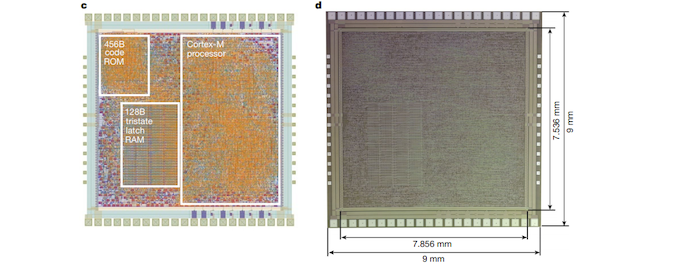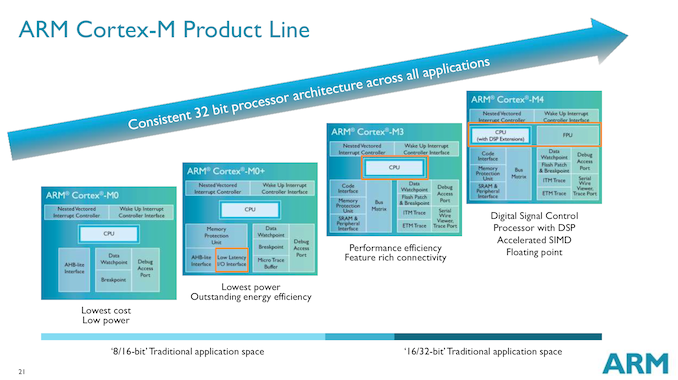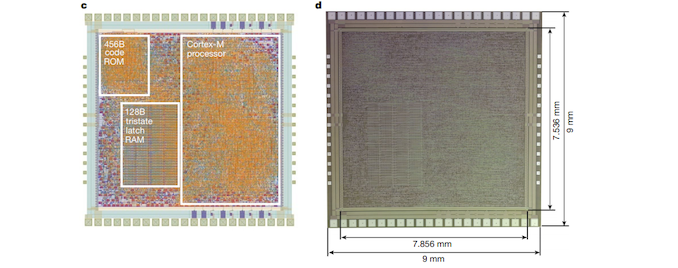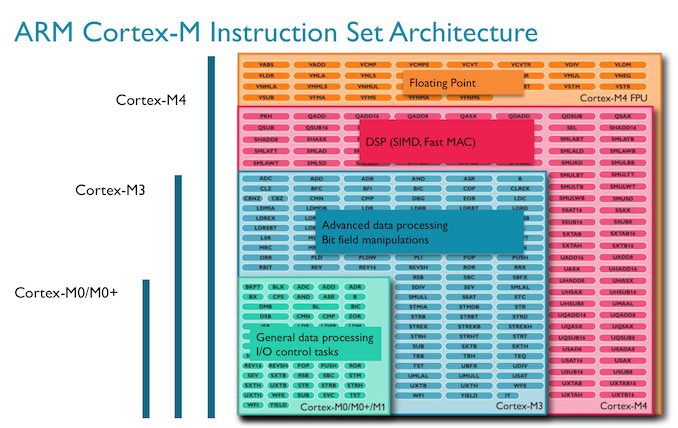PlasticArm: Get Your Next CPU, Made Without Silicon
by Dr. Ian Cutress on July 22, 2021 8:01 AM EST
Known for its core design IP that ends up in everything from IoT to smartphones to servers, Arm is now presenting that it has enabled one of its key microcontrollers in a new form factor: rather than using silicon as a base, the company has enabled a processor core in plastic. The technology has been in the works for almost a decade, but Arm has been waiting on the fabrication methods to create a fully working core. Now the company has something working in a tangible medium and the research has been published in Nature.
Creating a Plastic CPU
'Plastic' or flexible electronics have been with us for a long while, and usually involve large yet simple designs for electronics flow, or basic 8-bit adders, all the way up to displays. What we're seeing now is something a little different - the key news as published today is that Arm, in association with PragmatIC, has produced a fully functional non-silicon version of one of Arm’s most popular microcontrollers, the M0.
This M0 core sits right at the bottom of Arm’s core product stack, however the minimalist design is a popular one for silicon processors due to its low die area and power requirements for simple microcontroller tasks. So while it won’t be powering your next big device any time soon, lots of integrated electronics that you own will likely already be relying on M0 cores for fundamental control tasks.
PlasticArm, as it is now called, recreates the M0 core in a flexible plastic medium. This is important in two factors – first, the ability to enable processors or microcontrollers in something other than silicon will allow some amount of programmability in packaging, clothing, medical bandages, and others. Paired with a particle sensor, for example, it might allow for food packaging to determine when what is inside is no longer fit for human consumption due to spoilage or contamination. The second factor is cost, with flexible processing at scale being orders of magnitude cheaper than equivalent silicon designs. To Arm’s credit, the new M0 design here is reported to be 12x more powerful than current state-of-the-art plastic compute designs.
Details on the Plastic M0
In Arm’s press release, the company states that the Plastic M0 design has 128 bytes of RAM and 456 bytes of ROM, while also supporting a 32-bit Arm microarchitecture.
Inside the research paper published at Nature, we get fine-grained details.
The processor is built with a polyimide substrate and is formed through thin-film metal-oxide transistors, such as IGZO TFTs. This means that this is still technically a photolithography process, using spin-coating and photoresist techniques, ending up with the processor having 13 material layers and 4 routable metal layers. However as TFT designs have been widespread since the use of IGZO displays, the cost of production is still quite low.
The core supports the ARMv6-M architecture, with a 16-bit Thumb ISA combined with a sub-set of 32-bit Thumb. As with the regular M0, data and address widths are 32-bit, the in-order design is a 2-stage pipeline, and the core supports 86 instructions. The main difference to a silicon M0 core is that the register file, rather than being inside the CPU, is mapped to the 128-byte bank of DRAM. This is because the TFT design is better supported through a memory mapping technique. Despite this, the Plastic M0 core is binary compatible with all other Cortex M0 cores.
A typical die size for a silicon Cortex M0 using TSMC’s 90nm process is 0.04 mm2, whereas PlasticArm is using an equivalent 800nm TFT process and the core size is 59.2 square millimeters (7.536 mm x 7.856 mm). This makes the Plastic M0 core about 1500x the size of a standard IoT implementation. The other big difference is in frequency – the research paper states that the Plastic M0 runs at around 20-29 kilohertz with a 3V input; an M0 on a 180nm Ultra-Low Leakage process optimized for power rather than frequency, in Arms own design documents, can run at 50 MHz. That’s a 1600-2500x difference in frequency.
| PlasticArm: the Plastic M0 | |
| Process Node | FlexIC 800nm n-type IGZO TFT 200nm polyimide wafer |
| Die Size | 59.2 mm2 (core only) (7.536 mm x 7.856 mm) |
| Thickness | under 30 micron |
| ISA | ARMv6-M 16-bit Thumb + subset of 32-bit |
| Frequency | 20-29 kilohertz |
| Power | 21 milliWatts |
| Pin Count | 28 pins |
| Material Layers | 13 layers |
| Routable Metal Layers | 4 layers |
| Devices | 56340 39157 n-type TFT + 17183 resistors |
The Plastic M0 design uses 56340 devices, which is a mix of 39157 thin-film n-type transistors and 17183 resistors. Because the goal of this design was to not have any physically added resistors, the paper documents that implementing resistors at a TFT level within the layers involves using photolithography materials with higher resistance to enable a smaller size. Overall the paper predicts an equivalent silicon design of 18334 NAND2 gates. Overall power for the Plastic M0 core at 29 kHz is listed at 21 mW, 99% of which is static power (45% core, 33% memory, 22% IO). The 28 pins on the processor allow for clock signal generation, reset, GPIO, power, and debug.
Research Scope
In its press release, Arm states that one of the main barriers to production was down to technology and fabrication limitations – the project started in 2013 and even a prototype circuit was shown at Arm TechCon in 2015 using ring oscillators, counters, and shift register arrays. However a number of key questions were still left unsolved, mostly down to cell libraries for all the different components of a modern processor, along with tool flow and production. Over time Arm’s partner PragmatIC, through other projects it was working on, was able to build a range of cell libraries congruent with what was needed for an M0 processor. The first PlasticArm manufacture and validation was reportedly performed in October 2020.
Arm’s research points to cell library production being a key to unlocking further designs in the future. As microcontrollers and processors get more complex more elements (and different types) are needed to create an end-to-end useable product. Going beyond M0 thus requires research into enabling individual libraries in a TFT design. Beyond this, the research paper also states that low-power libraries are needed to enable scale. Because most of the power consumption on Plastic M0 is static power, driving that down through design and manufacturing is going to be a direction of research. There is also the angle of manufacturing – this was all done on a photolithography process using 200nm polyimide wafers using deposition techniques. An ultimate goal of plastic processors is that size is less of a limitation, and they can be ‘printed’ using conventional ink techniques. We’re not there yet, but this is certainly a step in that direction.
So while we can’t buy an Apple M1 built-in plastic just yet, there seems to be plenty of future potential in the technology.
Related Reading
- Arm Announces Mobile Armv9 CPU Microarchitectures: Cortex-X2, Cortex-A710 & Cortex-A510
- Arm Announces New Mali-G710, G610, G510 & G310 Mobile GPU Families
- Arm Announces Neoverse V1, N2 Platforms & CPUs, CMN-700 Mesh: More Performance, More Cores, More Flexibility
- Arm Announces Armv9 Architecture: SVE2, Security, and the Next Decade
- The Ampere Altra Review: 2x 80 Cores Arm Server Performance Monster













34 Comments
View All Comments
LeftSide - Thursday, July 22, 2021 - link
Took me three reads to realize it can process 86 different instructions, and not x86 instructions.I kept thinking, that’s weird, why does this super small processor support x86? Lol, I wonder if the engineers did this purposely.
mode_13h - Thursday, July 22, 2021 - link
> I wonder if the engineers did this purposely.No. This thing is far too resource-constrained for anything like that to be out of cuteness.
Wereweeb - Thursday, July 22, 2021 - link
I wonder if they could power this off an antenna that captures the energy from broadband or radio frequencies.mode_13h - Thursday, July 22, 2021 - link
I'm not a RF expert, but 21 mW seems like quite a lot, even for a large antenna.If anyone has relevant knowledge about harvesting ambient power, what are the best prospects and how much can they realistically provide? Could a thermocouple integrated into a wristband provide enough power from human body heat? How much power to RFID chips usually take?
TimSyd - Thursday, July 22, 2021 - link
RFID chips typically run 1 to 4uW (microWatts) so about 10,000 times less power than the plastic ARM (21mW).Harvesting RF energy yields very little power and the antennas are large (10's of mm in size) versus the RFID chip being powered which is typically less than 1mmsq.
You *might* get a few mW if the RFID antenna was on top of or within a few cm of the broadcast antenna but at reasonable distances of a few meters a few uW is the best you can hope for. Max ranges are about 10meters on a good day.
You also loose a lot in the conversion process of rectifying the RF signal down into a DC voltage for the chip to run off.
Wereweeb - Friday, July 23, 2021 - link
Thank you.CaptainChaos - Thursday, July 22, 2021 - link
Great! Just what the world needs: More plastic to foul the ecosystem!mode_13h - Thursday, July 22, 2021 - link
I think it's most likely to be integrated into existing products that already use such materials. And to the extent that it can reduce things like food spoilage, it has the potential to actually *reduce* waste.If you want to reduce plastic waste, invest in alternatives and scaling up of monomer-based recycling technologies.
asmian - Thursday, July 22, 2021 - link
No, the suggestion of integrating it into plastic food packaging seemed very odd to me, as that's where a vast amount of unrecyclable packaging waste is that needs to be cut out of the system for consumers (despite the pushback from manufacturers). Even if you charitably assume that all those currently unrecyclable materials are changed through enlightened self-interest to widely recyclable ones in any meaningful timescale, adding in highly complex chips made of different plastics bonded with metals and any other chemicals in those TFTs will make that just as unrecyclable in BULK, since this is being discussed as something to be produced at mass scale. Current recycling processing can't cope with mixed materials well, so this application will be an ecological disaster even if it saves a few food tons in some niche sector that can afford to put this sort of processing in the packaging.mode_13h - Friday, July 23, 2021 - link
> the suggestion of integrating it into plastic food packaging seemed very odd to meWhy do you presume it's for single-serving containers? There could be lots of bulk or industrial uses where you'd like to measure storage or transportation conditions.
> adding in highly complex chips made of different plastics bonded with metals
> and any other chemicals in those TFTs will make that just as unrecyclable
It's 7 mm on a side and probably paper-thin. I'd be surprised if there weren't more impurities in the typical recyclable container, already.